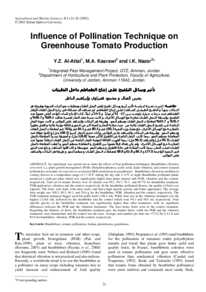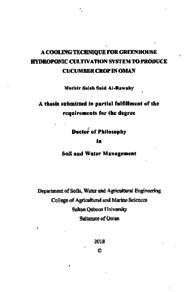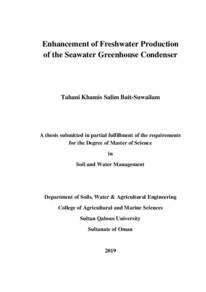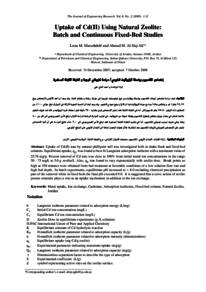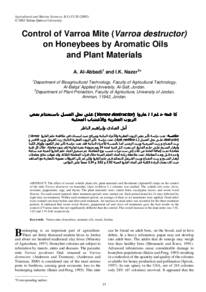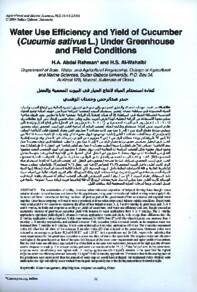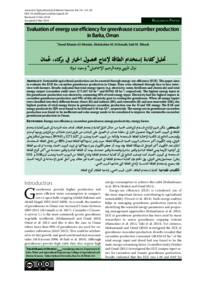Document
Influence of pollination technique on greenhouse tomato production.
Contributors
Kasrawi, M.A., Author
Nazer, I.K., Author
Publisher
Sultan Qaboos university
Gregorian
2003
Language
English
English abstract
An experiment was carried out to study the effects of four pollination techniques; Bumblebees (Bombus terrerstris L.), plant growth bioregulator (PGB) (Parachlorophenoxy acetic acid), hand vibration, and control (natural pollination) on tomato (Lycopersicon esculentum Mill) production in greenhouses. Bumblebees showed no problem in visiting flowers at a temperature range of 17-42°C during the day and 2-14°C at night. Bumblebee pollinated plants produced a yield per plant which was significantly higher than plants treated with PGB, vibration and the control, respectively. Fruit set of tomato flowers over 10 clusters was 99.1, 96.7, 76.7, and 65.7% for bumblebee treatment, PGB application, vibration and the control, respectively. In the bumblebee pollinated flowers, the quality of fruits was superior. The fruits were hard, with more seeds, and had a high specific gravity and better appearance. The average fruit weight was 100.3, 80.5, 84.1, and 70.6 g for the bumblebee, PGB, vibration and the control, respectively. The PGB treatment produced bigger sized but puffy fruits (108.4 ml). While fruit size in the vibration treatment was the highest (126.8 ml), followed by the bumblebee and the control which were 99.3 and 98.5 ml, respectively. Fruit specific gravity in the bumblebee treatment was significantly higher than other treatments, with no significant differences between the PGB and the vibration treatments. The least dense fruits were in the control treatment. Regarding the firmness of fruits, the bumblebee treatment gave the hardest fruits, while the PGB and the vibration treatments were intermediate and the control was the least. Average seed number per fruit was 177.0, 86.5, 61.8, and 89.8 for bumblebee, vibration, PGB and the control, respectively.
Member of
ISSN
2410-1079
Resource URL
Citation
Alattal, Y. Z., Kasrawi, M. A., & Nazer, I. K. (2003). Influence of pollination technique on greenhouse tomato production. Journal of Agricultural and Marian Sciences, 8 (1), 21-26.
Arabic abstract
أجريت تجربة لدراسة تأثير أربع وسائل تلقيح (هي النحل الطنان ومنظمات نمو النبات الحيوية وطريقة هز النباتات يدوية والتلقيح الطبيعي كشاهد) على إنتاج الطماطم. لم تشاهد أي مشكلة في زيارة النحل الطنان الأزهار الطماطم عند درجات حرارة تراوحت بين 17- 42°م نهارا و 2- 14° م ليلا. كان الإنتاج للنبات الواحد أعلى معنويا عند التلقيح بواسطة النحل الطنان مقارنة مع الوسائل الأخرى. وكانت نسبة عقد الثمار لعشرة عناقيد 99.1% و 96.7% و 76.7% 65.7% لمعاملات النحل الطنان ومنظم النمو وطريقة هز النباتات والشاهد على التوالي. وكانت جودة الثمار الناتجة عن تلقيح النحل الطنان عالية من حيث صلابة الثمار وكمية أكبر من البذور وكثافة نوعية عالية وأفضل مظهرا بالمقارنة مع الوسائل الأخرى. بلغ معدل وزن الثمرة 100.3 غم و 80.5 غم و 84.1 غم و 70.6 غم لمعاملات النحل الطنان ومنظم النمو وطريقة هز النباتات والشاهد على التوالي. وكان حجم التمار كبيرا (108.4 مل) و لكنها جوفاء عند المعاملة بمنظم النمو بينما كانت الثمار الناتجة عن الاهتزاز الأكبر حجما ( 126.8 مل)، وأصغرها نسبيا المعاملة بالنحل الطنان (99.3 مل) والشاهد (98.5 مل). بينما أظهرت الكثافة النوعية للثمار الناتجة عن النحل الطنان ارتفاعا معنويا عند المقارنة مع الوسائل الأخرى ولم يكن هناك فرقا معنويا بين الاهتزاز والمعاملة بمنظم النمو. وأعطت المعاملة بالنحل الطنان أصلب الثمار، بينما كانت الصلابة في حالة الاهتزاز ومنظم النمو متوسطة وكان أقلها الشاهد. وبلغ عدد البدور في الثمرة الواحدة 177.0 و 86.5 و 61.8 و 89.8 لمعاملات النحل الطنان ومنظم النمو وطريقة هز النباتات والشاهد على التوالي.
Category
Journal articles

